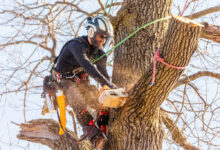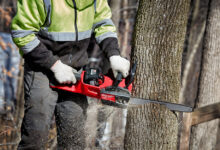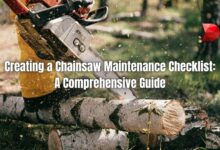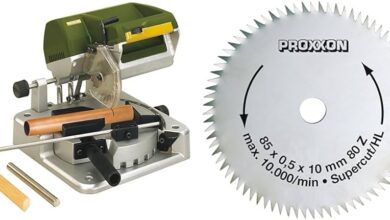Contents
- 1 Chainsaw Maintenance Introduction
- 2 The Importance of Chainsaw Maintenance
- 3 Advantages and Disadvantages of Chainsaw Maintenance
- 4 Chainsaw Maintenance Guide
- 5 Chain Sharpening
- 6 Air Filter Inspection and Cleaning
- 7 Spark Plug Inspection and Replacement
- 8 Bar and Chain Lubrication
- 9 Engine Checks
- 10 Fueling and Storage
- 11 FAQs
- 12 Conclusion
- 13 Closing Words
Chainsaw Maintenance Introduction
Chainsaws are versatile and powerful tools indispensable for various tasks, ranging from tree felling to firewood cutting. However, to ensure their optimal performance and longevity, regular maintenance is crucial. This comprehensive guide provides detailed instructions on how to maintain your chainsaw, covering everything from chain sharpening to engine checks, to keep your tool operating at its best.
Regular chainsaw maintenance not only enhances performance but also prolongs its lifespan. By keeping the chain sharp, the air filter clean, and the engine properly lubricated, you can minimize the risk of costly repairs and downtime, allowing you to tackle your projects with confidence.
This guide is designed for chainsaw owners of all skill levels, from beginners to experienced users. Whether you’re a seasoned arborist or a homeowner looking to maintain your occasional use chainsaw, you’ll find valuable information within these pages.
The Importance of Chainsaw Maintenance
Neglecting chainsaw maintenance can lead to a range of issues, including poor performance, increased wear and tear, and even safety hazards. A dull chain will struggle to cut through wood, straining the engine and wasting time. A clogged air filter will restrict airflow to the engine, causing it to run inefficiently and overheat.
Regular maintenance, on the other hand, keeps your chainsaw operating smoothly, efficiently, and safely. By adhering to the guidelines outlined in this guide, you’ll maximize the performance and longevity of your tool.
Advantages and Disadvantages of Chainsaw Maintenance
Advantages:
1. Enhanced performance: A well-maintained chainsaw will cut more efficiently and effectively, making your work easier and faster.
2. Extended lifespan: Regular maintenance helps prevent premature wear and tear, extending the lifespan of your chainsaw.
3. Increased safety: A properly maintained chainsaw is less likely to malfunction or break down, reducing safety risks.
Disadvantages:
1. Time investment: Chainsaw maintenance requires time and effort, which may be inconvenient for busy individuals.
2. Cost of parts: Replacing certain chainsaw components, such as the chain or air filter, can involve some expense.
3. Complexity: Some maintenance tasks, such as engine repairs, may require additional skills or specialized equipment.
Chainsaw Maintenance Guide
Chain Sharpening
A sharp chain is essential for optimal chainsaw performance. Dull chains cut slowly, put unnecessary strain on the engine, and increase the risk of kickback. Here’s how to sharpen your chainsaw chain:
1. Clamp the chain in a vise or use a chainsaw sharpening jig.
2. Choose the correct file size for your chainsaw chain.
3. Hold the file at a 30-degree angle to the tooth and move it towards you, applying light pressure.
Air Filter Inspection and Cleaning
A clogged air filter restricts airflow to the engine, causing it to run inefficiently and overheat. Check your chainsaw’s air filter regularly and clean or replace it as needed:
1. Remove the air filter cover.
2. Inspect the filter for dirt, debris, or damage.
3. If the filter is dirty or clogged, use a soft brush or compressed air to clean it.
Spark Plug Inspection and Replacement
A worn or fouled spark plug can cause difficulty starting or poor engine performance. Inspect your chainsaw’s spark plug regularly and replace it as needed:
1. Remove the spark plug cap.
2. Use a spark plug wrench to remove the spark plug.
3. Inspect the spark plug for wear or damage.
Bar and Chain Lubrication
Proper lubrication is crucial for the longevity of your chainsaw bar and chain. Use high-quality bar and chain oil to keep the components lubricated and prevent wear:
1. Fill the chainsaw’s oil tank with bar and chain oil.
2. Ensure that the oiler is functioning properly.
3. Regularly check the oil level and refill as needed.
Engine Checks
Regular engine checks are essential for maintaining peak performance and preventing major issues. Inspect your chainsaw’s engine for any signs of damage or wear:
1. Check the engine for loose bolts or screws.
2. Inspect the fuel lines for cracks or leaks.
3. Listen for any unusual noises or vibrations.
Fueling and Storage
Proper fueling and storage are important for maintaining your chainsaw’s performance and longevity:
1. Use the correct fuel mixture for your chainsaw.
2. Store your chainsaw in a cool, dry place.
3. Drain the fuel from the chainsaw if it will be stored for an extended period.
FAQs
1. How often should I sharpen my chainsaw chain?
2. What is the best way to clean my chainsaw air filter?
3. How do I know if my chainsaw spark plug needs replacing?
4. What type of bar and chain oil should I use?
5. What are the signs of a loose engine bolt?
6. How do I store my chainsaw properly?
7. What is the correct fuel mixture for my chainsaw?
8. How do I drain the fuel from my chainsaw?
9. What causes a chainsaw to kick back?
10. How do I reduce the risk of accidents when using a chainsaw?
11. Where can I find replacement parts for my chainsaw?
12. What is the warranty on my chainsaw?
13. How do I contact the manufacturer of my chainsaw?
Conclusion
By understanding and adhering to the guidelines outlined in this Chainsaw Maintenance Guide, you can ensure that your tool operates at its optimal potential and serves you well for years to come. Regular maintenance is an investment in your chainsaw and your safety, empowering you to tackle your tasks with confidence and efficiency.
Remember, a well-maintained chainsaw is a safe, efficient, and reliable companion for all your cutting needs. By dedicating time and effort to its upkeep, you’ll extend its lifespan, enhance its performance, and minimize the risk of costly repairs or accidents.
We encourage you to make chainsaw maintenance a priority in your tool care routine. By following the tips and best practices presented in this guide, you’ll not only safeguard your investment but also create a safer and more enjoyable experience when using your chainsaw.
Closing Words
We sincerely hope this Chainsaw Maintenance Guide has provided you with the knowledge and confidence to maintain your chainsaw to the highest standards. Remember, a well-maintained chainsaw is a valuable asset, and by following the guidelines outlined in this guide, you can ensure that it continues to perform at its best for years to come.
If you have any further questions or require additional guidance, please do not hesitate to contact the manufacturer of your chainsaw or consult with a qualified mechanic. Your commitment to chainsaw maintenance will not only extend its lifespan but also enhance your safety and the overall enjoyment of using this powerful tool.









